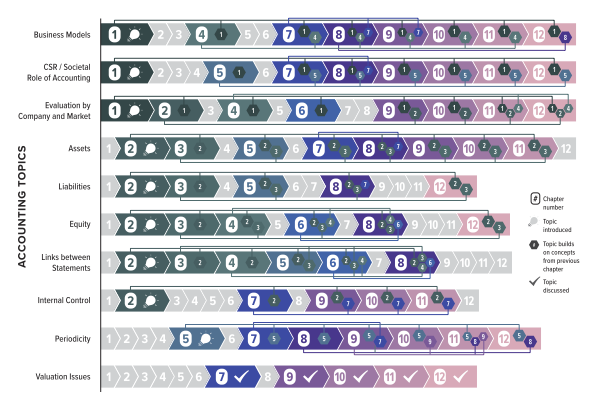Welcome
Welcome for students

So you’ve chosen to study accounting and master financial statements. Congratulations on this brilliant choice! Business, economy, and society rely on financial information to communicate information, safeguard markets, and protect investors. Not only that, but you and I use financial information every day!! We are consumers of groceries, clothing, utilities; we invest in pensions, RRSPs, and TFSAs; and we work as employees or contractors. If we understand financial information, we can make better choices in each of these roles.
As you read this book, I hope it inspires your curiosity, helps you recognize financial information in everyday life, and motivates your journey to financial statement mastery.
Information for educators
Students often find new accounting terminology and concepts overwhelming, a feeling that is compounded by the academic writing style of traditional textbooks. This workbook takes a different approach, using a conversational style which is more accessible. Accounting concepts are introduced and followed up by directed examples to guide students through the process of creating and evaluating financial statements. Lastly, students complete exercises on their own, self-monitoring for mastery, before moving on to other concepts.
The style and approach used here are a product of mentorship and lived experience. Ultimately, there is nothing new under the sun: accounting concepts and pedagogical approaches in this textbook are not new. However, this resource blends financial accounting content with established pedagogical approaches in a way that is unique. Specifically, this textbook is the meeting of my professional life as an accounting educator with my family life as a parent of kids with educational disability. As I mature as an educator, my approach increasingly bends toward curiosity and playful practice with an aim to improve educational outcomes for students and the accounting profession. And have fun in the process!
See-one-do-one approach
The see-one-do-one approach is not new. I was introduced to this approach through my son’s Montessori preschool and Suzuki music lessons. Children learn many skills efficiently through observation and repetition: skills such as counting, reading, spelling, and screeching Twinkle Twinkle little star on the violin… Yet adult learning materials, particularly in ‘serious’ topics such as financial accounting, are not nearly as engaging.
In 2017, Dr. Morina Rennie entrusted me with her course materials for Intermediate Accounting II, which included an extraordinary resource, playfully entitled Accounting for Income Taxes: Think and Do Booklet. The levity, turn-taking, and conversational language of this introductory accounting resource arises from Dr. Rennie’s booklet, which persuaded me that wonder, curiosity, and playfulness is an effective learning strategy at any age.
Scaffold approach
The scaffold approach incorporates two learning strategies. The first is chunking: students learn a short concept and have the opportunity to practice it immediately. This technique is the cornerstone of Montessori and Suzuki approaches.
The second strategy is integral to the structure of this introductory accounting resource. Financial Statements are introduced in sequence to reduce overwhelm, beginning with the Statement of Financial Position. This strategy emphasizes retained earnings and tacitly familiarizes students with the asset-liability approach (also referred to as Balance Sheet Primacy, a concept embedded within national and international conceptual frameworks). I taught seminars at Lancaster University in the UK for Prof. Paul Taylor’s AcF100: Introduction to Accounting and Finance course. I draw heavily in chapters 2-5 on the approach he used and his way of explaining the concepts that I am seeking to explain, which I remember with much appreciation, although this textbook is a blend of the approach used by Prof. Taylor and Canadian approach.
This scaffolded approach bridges the educational needs of accountants and non-accountants to produce a resource that gives business students functional accounting skills and provides accounting students with the precision required for Intermediate Financial Accounting.
How to Use this Workbook
This book is organized in a pattern of Think, See, and Do. The Think sections introduce important concepts; See sections show how to implement concepts using practical examples; and the Do sections give you a chance to practice the concepts yourself. Each section is marked with a unique icon to mark transitions.
|
The Think icon means the section focuses on concepts. This may mean introduction of a new topic or enhancement of a topic introduced earlier. |
|
|
The See icon is used before an illustration of applied concepts and is often followed by the phrase “My turn”. In this section, I will demonstrate how to solve a problem. Pay close attention to the See sections because it will guide you to solve a similar problem. You will likely refer back to the See section as you move into the Do segment. |
|
|
The Do icon indicates that it’s your turn to try an example. These examples are in Excel format with templates and step-by-step instructions to guide your work. Take the time to practice concepts in the Do section before moving on. Mastery comes with practice! |
The Think, See, Do pattern repeats. With each iteration of the Think, See, Do pattern, concepts grow from introductory ideas to sophisticated financial applications. So it is important to engage thoroughly by practising in the Do sections to master earlier concepts before moving on to more complex ideas.
Tackling accounting exercises
How do you tackle an accounting exercise? You may notice that accounting exercises are complicated with lots of information to sift through. Start by reading the opening sentence or two, then skip down to the end of the exercise and look for the word “required”. The “required” section tells you what question you’ll need to answer (in other words, what’s required of you in the exercise) so you can identify the most important information as you read through the exercise in full. In short, “required” is a visual clue that gives you contextual information to pick out the most relevant information in the exercise.

